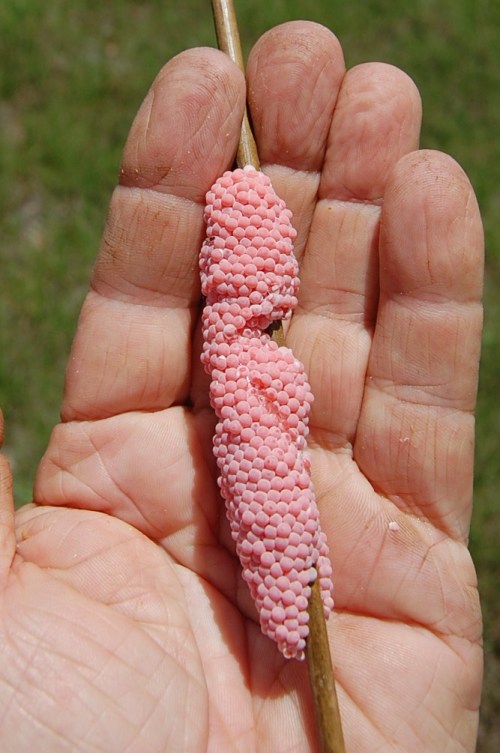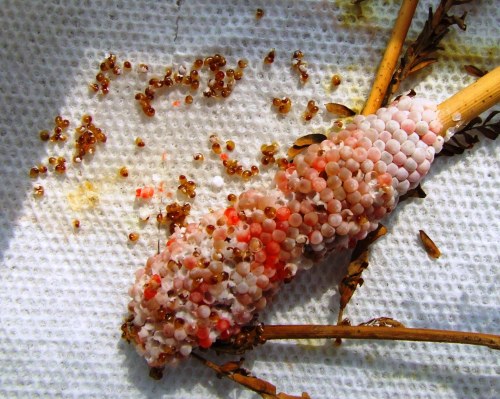
I have often wondered why the eggs of Pomacea canaliculata and P. insularum are not quickly devoured by any number of predators. The pink clusters draped on emergent plant stems around lakes could not be more obvious. However, these numerous clumps of protein and carbohydrates go largely untouched aside from occasional attacks by red fire ants, Solenopsis invicta (see post entitled, “Rematch: Pomacea versus Red Fire Ant”). Finally, a fascinating answer to this mystery has been provided by the outstanding team of Professors Dreon, Ituarte, and Heras of the National University of La Plata in Argentina.
Throughout the natural world, undefended eggs provide easy, nutritious meals. It is common for half of them to be lost to predation. Most animals rely on either hiding their vulnerable ova, guarding them, or producing so many eggs that a future generation is assured. No doubt Pomacea are prodigious breeders, but they also employ “aposematism,” a common characteristic of dangerous prey. Using warning signals, such as color, sound, or odors, certain prey clearly advertize that it is unwise to attack them. Such warnings are beneficial to both predator and prey. Certainly, the blatant display of bright-pink eggs by exotic Pomacea is the form of aposematism, called “warning coloration,” but what could possibly be danger in eating them?
Endowing eggs with chemical defenses in not uncommon in invertebrates, and Dreon, Heras, et al., (2008) already established that Pomacea canaliculata eggs contained such a predator repellant. The authors found that a rare protein neurotoxin was produced by albumen secretory cells in developing Pomacea canaliculata eggs. Further, they demonstrated that injections of this neurotoxin, called Perivitellin-2 or PV2, had lethal effects on rodents (LD50, 96 h @ 2.3 mg/kg) primarily because of damage to their spinal cords. However, this neurotoxin was fragile (heat sensitive), however, and there was evidence of antibody response to sublethal doses. The presence of PV2 did not seem enough to dissuade almost all predators from consuming Pomacea eggs suggesting some complementary defensive mechanism.
The rest of the story is provided in a publication this month by the same team (see Dreon, Ituarte, and Heras (2010) in Recent Publications). It is hard to imagine eggs that are not highly nutritious, and developing apple snail ova are “filled with large amounts of polysaccharides and proteins,” as the authors put it. However, there is another surprise for predators in the perivitellin fluid that surrounds the fertilized Pomacea oocyte, besides PV2. The same brightly-colored, caratenoid protein, called ovorubin, that warns away predators and blocks damaging solar radiation is also a proteinase inhibitor. Feeding trials revealed that rats fed ovorubin lost weight because it binds to trypsin, a common digestive enzyme that breaks down proteins.
In an elegant defense of her young, the female snail not only adds a neurotoxin to the perivitellin fluid, but for good measure, colors it bright-pink with a compound that impedes digestion of protein. “This [protease inhibitor] role has not been reported in the animal kingdom, but it is similar to plant defenses against herbivory,” state the authors. Only red fire ants are determined enough to ignore the apple snail’s clear warning. A common TV advertisement trumpets that chicken ova are “incredible, edible eggs.” Well, the apple snail’s brightly-colored advertisement to predators is: “These are my incredible, indigestible eggs!” Posted by Jess Van Dyke
[Note: I started this weblog two years ago. Subsequently, there have been 24,000 hits from all over the world. I am grateful to all my old and new friends. Thanks for your help and encouragement!]
 Within an egg shell, the rapidly developing embryo needs plenty of oxygen. Using an oil to kill eggs by impeding oxygen transfer through the shell is nothing new. For instance, the USFWS has recommended mineral oil for use on nuisance geese nests. Why not use vegetable oil to kill apple snail eggs?
Within an egg shell, the rapidly developing embryo needs plenty of oxygen. Using an oil to kill eggs by impeding oxygen transfer through the shell is nothing new. For instance, the USFWS has recommended mineral oil for use on nuisance geese nests. Why not use vegetable oil to kill apple snail eggs?